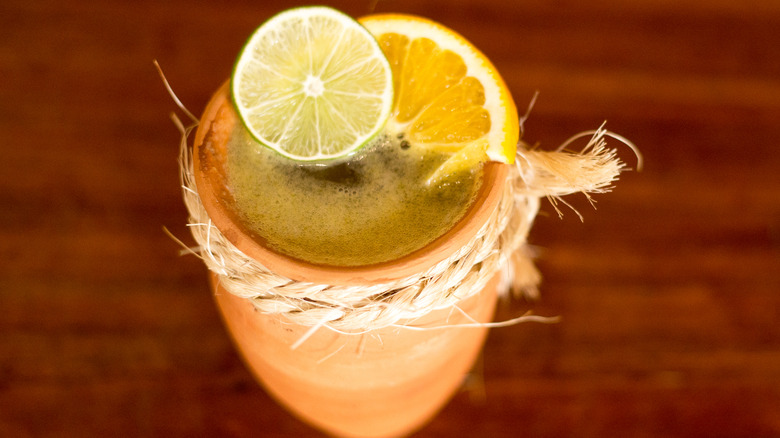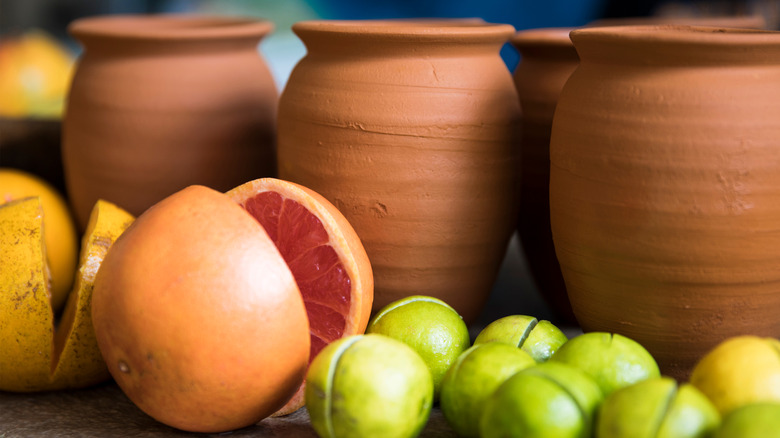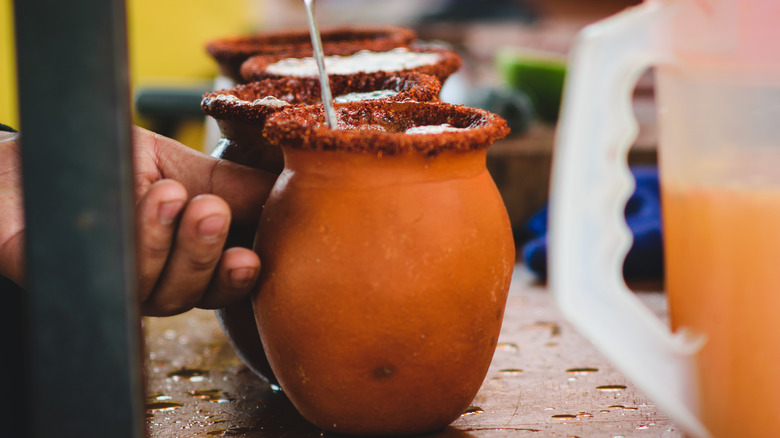The Cantarito Is The Tart Mexican Cocktail Paloma Fans Will Love
Cocktails can deliver a variety of moods, from the buzz of wintery, boozy sippers to the refreshing zing of fruity summertime mixes. When imagining a tequila-based sling, it's likely the latter comes to mind — who doesn't want a margarita on a sunny patio?
Largely, it's due to the fact tequila's bright fruit and earthy notes align beautifully with energizing citrus. The blanco style, especially, melds perfectly with lime or grapefruit, like in a paloma. However, less-mixed reposado tequila — the style aged in barrels for up to a year — can also produce a beautiful grapefruit-based beverage.
For an easy-going yet delicious example of such a cocktail, give the cantarito a try. Like a paloma, there's grapefruit and lime juice; however, the flavor's complexity is accentuated by the addition of grapefruit soda, orange juice, and salt. Plus, the drink is served in a clay cup, which not only maintains temperature but also imbues its own effect on the taste. The result is a tart yet easy-to-drink cocktail that's brimming with flavor. Let's look at how the cantarito came about.
Background of cantarito
The origins of the refreshing cantarito are unknown; however, its existence interlinks with the clay vessel for which it's named. The eponymous jar was once much larger in size, and used to transport water, especially in the Jalisco region. Since the Mexican state is also famed for tequila production and other agave spirits such as raicilla, clay vessels were also used in the distilling process.
However, when it comes to the cantarito, it's all about how the cocktail is served. The clay jar's insulation properties keep the liquid cold — an attribute that's beneficial considering the cocktail's fizz factor. Additionally, the clay cup, which can also be called a jarrito de barro (meaning little clay jug), even impacts the flavor. The clay's alkaline mineral qualities tone down some of the sour notes, melding together the cocktail's ingredients, and it can bring a certain earthiness to the drink, too. Originating as a drink served at roadside restaurants, cantarito functions as an easy-to-like, casual tipple. You'll see the clay cups at most Mexican bars. It doesn't involve technical bartending, nor does it call for top-shelf tequila. Let's dive into what goes into it.
How a cantarito is made
The cocktail consists of three principal components — tequila, a blend of citrus juices, and a soda. Reposado tequila is more frequently used since its more barrel-flavored notes add a unique dimension, although blanco is also acceptable. The juice element varies but typically doesn't veer into overly sour notes. Instead, a common proportion is equal amounts of grapefruit and orange juice, with a smaller portion of lime juice. Due to its slightly less sweet character, pink grapefruit is the most commonly employed type. And when it comes to the soda — as long as it's grapefruit flavored, the sky's the limit. In alignment with the cocktail's Mexican roots, Jarrito's is a common choice, although U.S.-made Squirt also works for the task. Alternatively, branch out into other brands of your preference.
Assembling the drink is fairly straightforward. First, the cantarito cup is placed in cold water for ten minutes to wet the clay. (If you want to make these at home, the cups can easily be bought online.) Next, an optional rim — comprised of chamoy, Tajín seasoning, or chile powder is applied. Some ice is added to the jar, and the ingredients, sans soda, are stirred in the cantarito itself, alongside a pinch of salt for added complexity. Then, the cocktail is topped with soda, and optional citrus slices are secured on top. Sip — and enjoy more than one — the drink goes down especially well come summertime.


